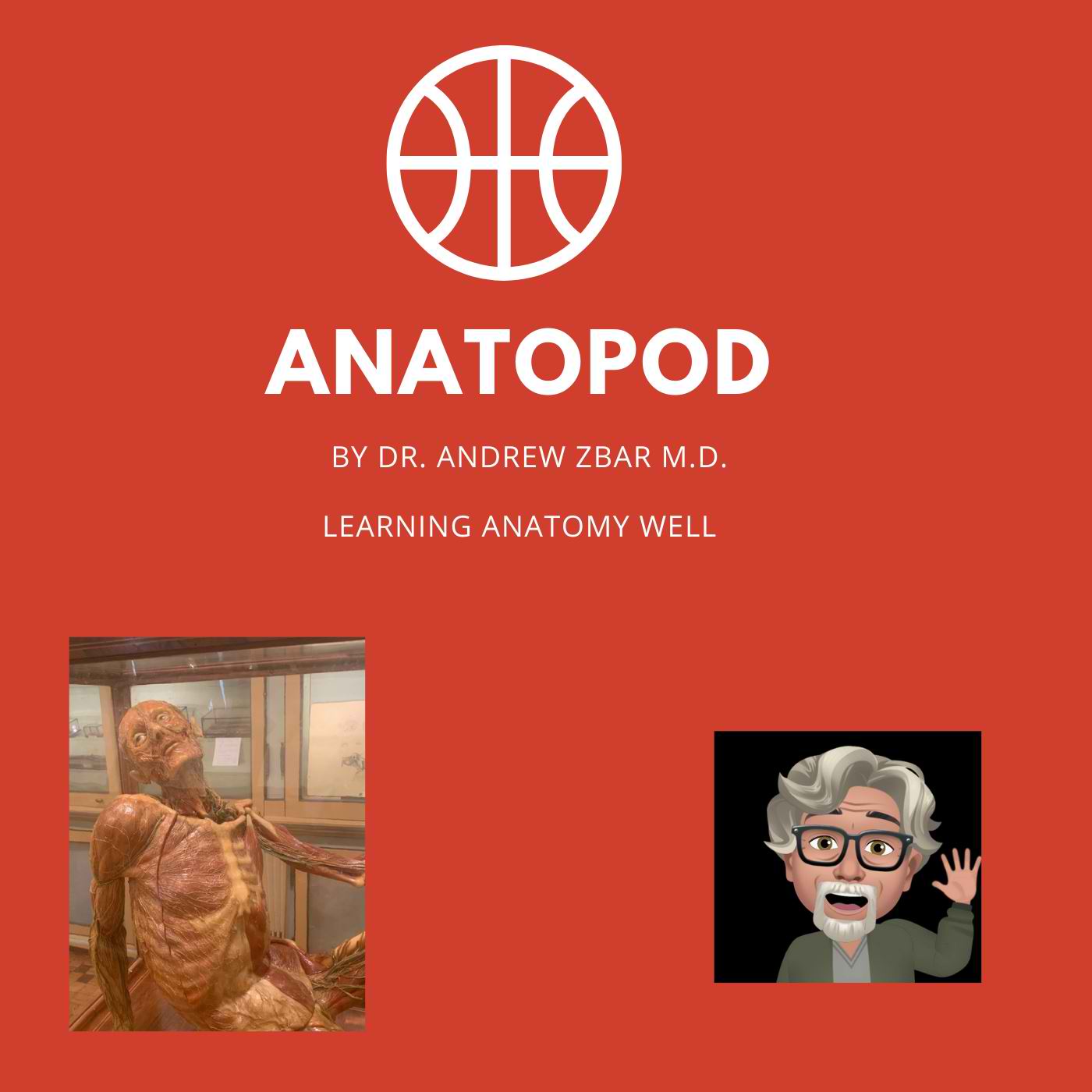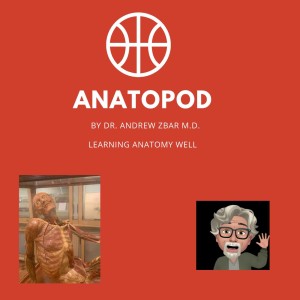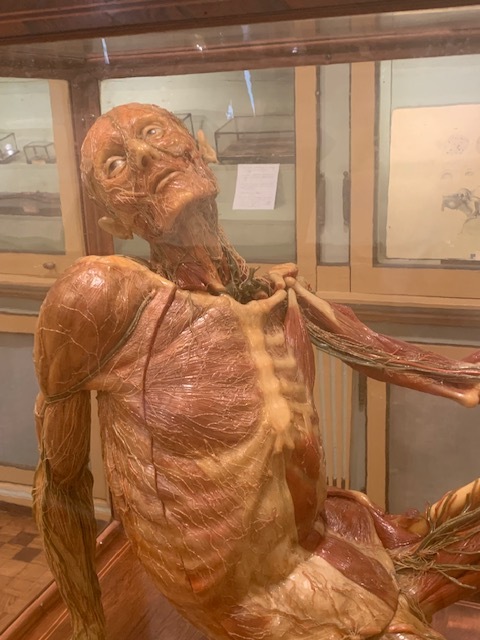
20.1K
Downloads
91
Episodes
Welcome to a new and exciting Podcast called ANATOPOD designed to teach anatomy. ANATOPOD aims not just to teach anatomy well to a high and practical level but also to introduce the history of anatomy and dissection of the cadaver. I appreciate that anatomy is a visual tradition but it wasn't always like that. In the Renaissance, anatomy was taught from textbooks written by the Greek Galen in the first century A.D. Perhaps it might seem unusual to revert anatomy teaching to an aural basis but it is recognized too that in this modern age anatomy departments in universities all over the world are dispensing with their raision d’être, the cadaver, replacing it with surrogates and models. We still do not know the effects of this change on the care of our patients but what we do know is that the cadaver is part of our death culture as much as it touches so many other aspects of society at large.
Episodes

Sunday Mar 28, 2021
THE ARTERIAL CIRCULATION OF THE HEAD AND NECK - REMIX
Sunday Mar 28, 2021
Sunday Mar 28, 2021
This is the same as the last podcast but has intro and outro music in the remix! One of my favourite short pieces composed by Joseph Horovitz for the BBC series Rumpole of the Bailey (written by Sir John Mortimer).

Sunday Mar 28, 2021
ARTERIAL CIRCULATION OF THE HEAD AND NECK
Sunday Mar 28, 2021
Sunday Mar 28, 2021
AHN 8.
Consideration of the carotid sheath (revised) and the external carotid artery (ECA) and its individual branches, the internal carotid artery (ICA) in the neck, the component parts of the vertebral artery, the basilar artery and the Circle of Willis (anatomical and functional aspects). The significance of archetypal ECA anastomoses (maxillofacial and faciopharyngeal) are mentioned.
The next podcast is on the venous anatomy of the head and neck (including the dural venous sinuses and emissary veins).

Friday Mar 19, 2021
Friday Mar 19, 2021
In this first of two podcasts I set the political and economic scene of the Netherlands as it emerged from the 80 Years War with Spain. In the period between 1600 and 1700 over one million paintings were commissioned and some of these included the so-called Anatomy Lesson Paintings of Northern Holland showing the Praelector Anatomiae (today’s equivalent of a City Chief Medical Officer or a Crown Coroner) teaching aspects of cadaveric dissection on a subject anatomicum. The genre of painting placed the surgeons and anatomists on par with the burghers and civic guardsmen who commissioned their collective portraits for posterity, attracting the likes of great painters like Rembrandt.

Sunday Mar 07, 2021
ANSWERS TO THE HEAD AND NECK QUIZ NUMBER 1
Sunday Mar 07, 2021
Sunday Mar 07, 2021
ANSWERS, DISCUSSION AND EXPLANATION TO THE HEAD AND NECK QUIZ (No.1).

Friday Feb 26, 2021
The Birth of Science and the Philosophy of Anatomy - The History of Anatomy
Friday Feb 26, 2021
Friday Feb 26, 2021
This podcast explains the debate in the dissecting halls during the Renaissance and beyond between Galenists and Cartesians. William Harvey (1578-1657) had developed his new experimentation as the methodology of science. Afterwards anatomy (like physics, astronomy and chemistry) needed to leave the natural philosophies and fall under the rubric of the developing sciences. Anatomy then became concerned with the expression and the understanding of Nature and left behind the metaphysicians more concerned with explaining human nature. And in so doing the grimy anatomists became scientists and arbiters of truth.
For some, the anatomy rooms were intensely religious places where an anatomist could come to understand the mind of God. But for others they were a place to separate oneself from theology and theologians. They were, however, certainly dangerous places for the dissenting mind. The expression of one’s own views from these halls contributed to the death of Michael Servetus (1509-1553) for outlining his ideas on the pulmonary circulation but who made the mistake of including them in his 1553 Restitutio Christianismi which also attacked the infallibility of Christ. For this John Calvin (1509-1564) ensured that Servetus was burned at the stake, ordering the kindling saplings to be younger and greener so that the fire would last longer. The same fate awaited Giordano Bruno (1548-1600) who in expressing his agreement with a heliocentric universe where the earth orbited the sun, was also consigned to the flames. In this podcast I outline how without Galileo, Kepler and Newton even anatomy would have stumbled to advance.
The next podcast moves on chronologically and is on the Anatomy Lesson paintings of northern Holland.

Wednesday Feb 24, 2021
INFRATEMPORAL AND PTERYGOPALATINE FOSSAE - EXPLAINED
Wednesday Feb 24, 2021
Wednesday Feb 24, 2021
This podcast describes the boundaries and approach to the infratemporal and pterygopalatine fossae and the entry and exit chambers of the latter as well as the contents:
Includes a discussion of the maxillary artery, the mandibular division of the trigeminal nerve (V3), the muscles of mastication (temporalis, masseter, medial and lateral pterygoid), the pterygopalatine ganglion and the pterygoid venous plexus.
The otic ganglion is revisited.
The temporomandibular joint (TMJ) is also considered in this podcast.

Tuesday Feb 23, 2021
HEAD AND NECK QUIZ NO. 1
Tuesday Feb 23, 2021
Tuesday Feb 23, 2021
FIRST HEAD AND NECK QUIZ. Multiple Choice format.
There are 15 questions. Some questions may have multiple answers that are correct.
These questions have been posed in order to appreciate whether you understand basic areas of the Head and Neck anatomy rather than particular questions.
I will discuss the answers in a later podcast.
Good luck!
AZ

Thursday Feb 18, 2021
Revolutionizing Dissection: From Galen to Vesalius
Thursday Feb 18, 2021
Thursday Feb 18, 2021
In this podcast I discuss the milieu into which the Belgian anatomist Andreas Vesalius (1514-64) arrived. Paris lagged well behind Padua in dissection skills and Vesalius introduced the radical idea that he should dissect the body himself simultaneously as he was teaching, rather than just reading to the students aloud from the ancient textbooks. There were so many findings that were discordant with Galen that Vesalius was prompted to write a new anatomy text in 1543 [the] Fabrica Humani Corporis (The Fabric of the Human Body). Perhaps it was not surprising that the book was published in the same year as Nicolaus Copernicus (1473-1543) published his heliocentric theory of the earth orbiting the sun in his De Revolutionibus orbium Coelestium. In the Fabrica, Vesalius included some remarkable images of his dissections drawn by the professional artist Jan Stephan van Calkar (1499-1546) a student of the Venetian Master Titian. The effect was so revolutionary that we might consider all dissections as effectively Pre- or Post-Vesalian.

Tuesday Feb 09, 2021
Tuesday Feb 09, 2021
Part 2 of the Anatomization of Art considers how differences in the personality of Leonardo and Michelangelo influenced their ability to dissect the corpse. By the end for Leonardo there was more legend than influence from a mind whose genius Goethe (1749-1832) had written "müde sich gedacht" (had thought itself weary). The science historian George Sarton (1884-1956) wrote of Leonardo that [his] “originality was due not only to his inherent genius, to the penetration and comprehensiveness of his mind but also to his ignorance”.
But in his haze of cosmic misunderstanding, how blissful to be so ignorant!
Of Michelangelo, it might be said that he was more of a man of the people, blessed (or perhaps cursed) with the common frailties and conceits that made him and his work more accessible. According to his biographer Ascanio Condivi (1525-1574) Michelangelo dissected through need. But Leonardo dissected through passion.

Thursday Feb 04, 2021
BRAINSTEM NUCLEI AND THE CRANIAL NERVES
Thursday Feb 04, 2021
Thursday Feb 04, 2021
ANATOMY HEAD AND NECK 6
In this podcast I discuss the brain stem and its ascending/descending tract arrangement in broad terms and a bit about the nuclei such as the nucleus ambiguus and the nucleus solitarius. For those uninterested in this I would skip the first half hour.
I then go on to discuss each of the cranial nerves as they emanate from the brain stem as well as the course and branches of these nerves and individual lesions of the cranial nerves. These clinical lesions are based upon the anatomy described.
